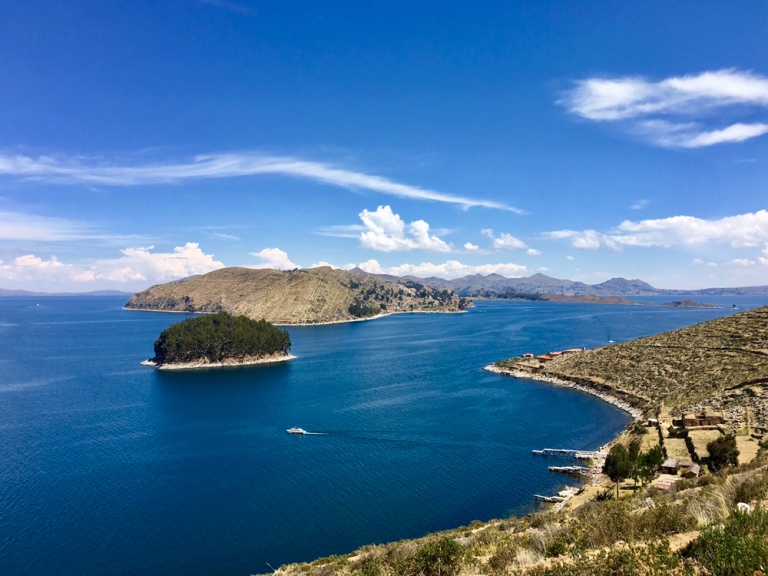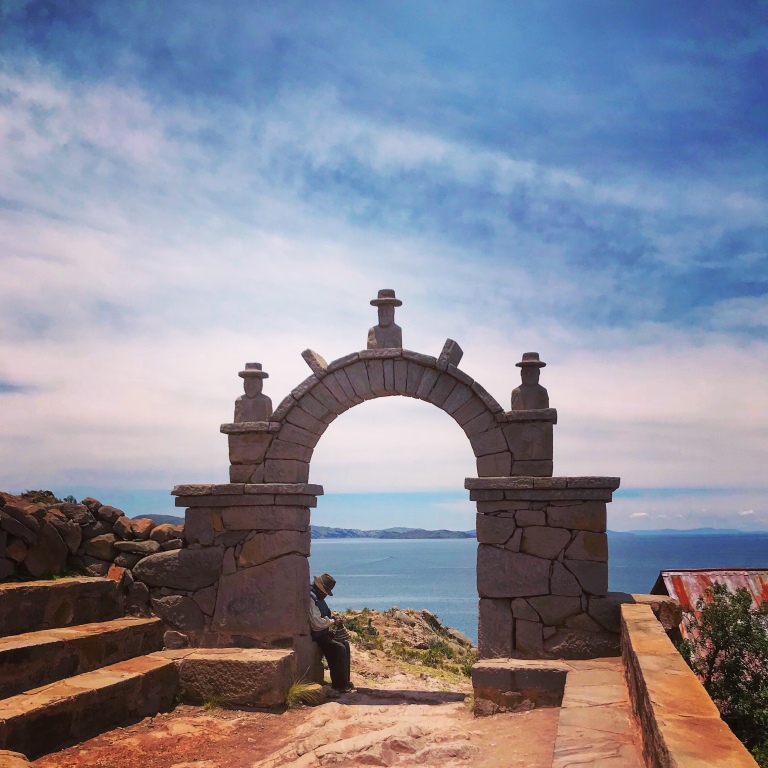STOP 36 | Day 113 to 114 |
To get to Peru, we headed overland from La Paz in the early morning with a bus service offered by Bolivia Hop. Bolivia Hop is a great option for those looking to travel to/from Bolivia and Peru. As the company name implies, the bus is hop-on and hop-off, which allows flexibility in planning your trip and is convenient with its hotel pick up and drop offs. There is even a tour guide on the bus to help manage the process.
Lake Titicaca, the highest navigable lake in the world and largest lake in South America, sits at an elevation of 12,507 feet and has a surface area of 8,372 square kilometers. The lake is on the border of Bolivia and Peru. Our first glimpses of Lake Titicaca was at Tiquina Mirador which is approximately 45 minutes south east from Copacabana (the main border town between Bolivia and Peru on Lake Titicaca). To save having to drive around the lake, Tiquina Mirador is a popular point for people to cross on canoes or barges. With our bus loaded on a barge we crossed the strait on a passenger boat.
Following the lake crossing we stopped in the town of Copacabana for approximately 4 hours. As we were short on time (needed to fly back to Canada for the ski season!), we didn’t stay overnight. Copacabana is a popular stop, as the town is on Lake Titicaca and it is a base for exploring Isla del Sol and Isla del Luna. We did manage to take a tour to Isla del Sol with Bolivia Hop during the few hour stop. We were slightly underwhelmed with the half day tour, as most of the time was spent on the boat. The boat trip out to Isla del Sol took over an hour (the Bolivia Hop boat seemed to be slower than some of the other catamarans headed to the island). Although the boat ride was very picturesque, it was far from peaceful due to a couple young Swedish girls talking extremely loudly the entire boat trip (A was puzzled as to how they had so much to talk about)! Once at the island we hiked from the sun temple to the town of Yumani. Given the altitude it is recommended to take the hike at a slower pace. Along the way we appreciated the views of the island and the lake. We also passed several agricultural terraces, tiny settlements and llamas grazing. Back at Copacabana we boarded the bus to take us across the border to the town of Puno (Peru’s equivalent town on Lake Titicaca).
Crossing the border overland was very seamless with Bolivia Hop. The tour guide was very informative and helpful as we transited over to a new bus and tour guide in Peru (the buses in Peru are larger as they don’t have to cross a lake on a barge!). Arriving in Puno we transferred onto a minibus, which was needed to navigate the narrow streets, to our hotel. We took the advice of the receptionist and headed to Mojsa Restaurant for dinner. The restaurant was a nice change from the touristy offerings of western food (hamburgers, pizza, pasta). We thoroughly enjoyed the llama steak and grilled trout. They even had a soothing drink to help with altitude sickness made with ground coca, honey and lime.
The next day we headed on an all day tour of the floating islands. We booked our tour through Bolivia Hop and it was operated by Kollasuyo Travel. There are many operators that offer these full day tours, all with very similar itineraries. Our operator’s boat was smaller than some of the others that we saw (and ours was fully packed). The tour was also bilingual, English and Spanish. The first stop was The Floating Island of Uros. The Uros people live across 42 floating islands, which are made with totora reeds. As tourism is their main source of income, the locals are accustomed to having visitors. They had a detailed presentation of how the islands are constructed as well as a demonstration of their daily activities. It was interesting to see a cross-section of the island, as you could see an example of the layers of reeds. As the reeds rot fairly quickly new reeds are added to the top every few months. We had the opportunity to see the houses, boats (all made with reeds) and stove for cooking. Next we headed on the boat to Taquile Island; the island’s highest point is 13,287 feet above sea level. We could see the impact of tourism as we walked across the island, with numerous stalls selling crafts, children walking around with goats (asking for money for pictures) and even some locals begging along the way. The walk showed off similar scenery to the Isla del Sol trek, terraced farming and tiny settlements. After passing the central plaza we stopped for lunch. As we enjoyed some fresh fish and rice, we learnt about the handwoven textiles produced on the island. Knitting is exclusively performed by males, beginning in early boyhood. Women spin wool and use vegetables and minerals to dye the wool to be used by the community. Women are also the weavers of the Chumpis, the wide belts with woven designs worn by everyone in the community of Taquile. This was our last stop on the tour and we had a 2.5 hour boat ride back to Puno. We could see how people have called the tours “very touristy and fake”. However, like some of the other places we have visited, tourism is now a way of life for the locals. The altitude also seemed to be catching up with us, which made the day on the boat and hiking not that enjoyable. Unfortunately we had an overnight bus to Cusco next on our itinerary.










One thought on “Lake Titicaca, Bolivia & Peru”